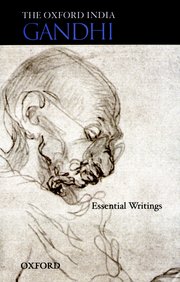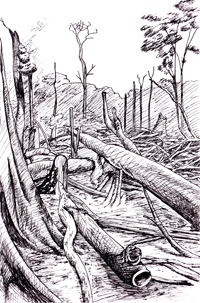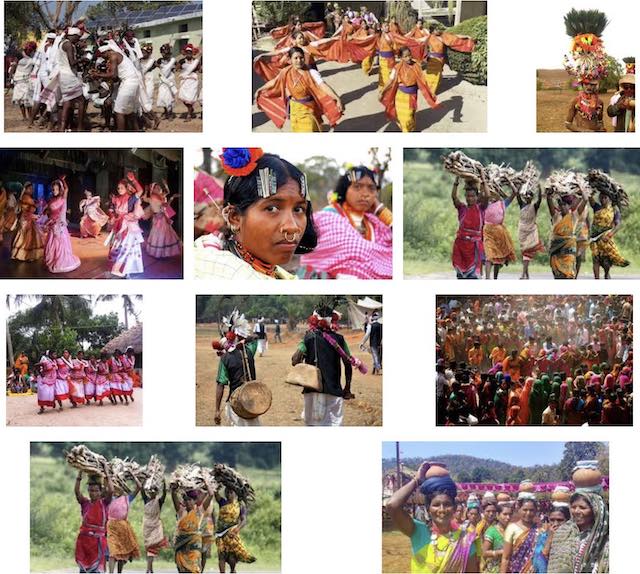“The Hindu Kush-Himalayan region holds the third largest body of frozen water in the world, and is warming at double the global average. It stands to lose one third of its glaciers by 2100 – creating huge risk to mountain communities, ecosystems and nature and the quarter of humanity downstream.” – Deepshikha Sharma (climate and environment specialist at the International Centre for Integrated Mountain Development, ICIMOD) quoted by BBC Podcast “The Climate Question” | Learn more | Biodiversity and development – Himalaya >>
Saving the forests of Garhwal by sticking to trees. Fighting a big dam by living in submerged waters. These movements redefined the greening of India.
STICKING TO A CAUSE
Chipko Movement, 1973“In the wake of reckless deforestation, a unique movement has bubbled,” observed India Today in March 1982. The 1980s saw the debate on environment move from just deforestation to the larger issues of depletion of natural resources.“
Chipko movement in the Garhwal Himalayas, shoved aside urban armchair naturalists.
Led by Chandni Prasad Bhatt and Sunderlal Bahuguna, it was a people’s revolt against mindless deforestation.
And they did it simply. By hugging trees when the woodmen came to axe them,”said India Today in January 1990.
Source: “10 most powerful movements” by Purvi Malhotra (India Today, 19 December 2008)
URL: https://www.indiatoday.in/magazine/environment/story/20081229-10-most-powerful-movements-738539-2008-12-19
Date Visited: 31 May 2021
How much does biodiversity matter to climate change? The ecosystems of the land and ocean absorb around half our our planet warming emissions. But these are being destroyed by human activity. At the same time, climate change is a primary driver of the destruction of these habitats and biodiversity loss. If biodiversity is our strongest natural defence against climate change (as it’s been described), what’s stopping us from doing more to protect it? | For up-to-date reports listen to The Climate Question (BBC) | United Nations on climate change >>
With the passing of Sunderlal Bahuguna on May 21, the great social activist who added the “Chipko Movement” to the glossary of environmentalists worldwide, COVID has found one of its most illustrious victims. Bahuguna was hospitalized on May 8 after testing positive for the coronavirus and breathed his last nearly two weeks later, dying from complications arising from COVID. His death is rightly being mourned as a monumental loss to the Indian environmental movement. He was also, however, one of the last great witnesses to the Gandhi era—that is a loss which is almost inestimable. […]
“What do the forests bear? Soil, water and pure air.” The women of the Chipko movement, founded by Chandi Prasad Bhatt but most closely associated with the name of Bahuguna, coined this slogan. Bahuguna’s life of activism did not, however, commence with the Chipko movement. Inspired by Gandhi, Bahuguna, after flirting with Congress party politics, had in his 20s taken up anti-untouchability work and he also closely worked with village women to create an anti-liquor drive in the hills. The other slogan that would grow out of the Chipko movement, “ecology is permanent economy”, was Bahuguna’s own distinct contribution. The Chipko movement has most often been understood as an attempt, in which village women played the critical role, to prevent contractors—most of them coming from the plains—from cutting down trees for the lumber industry. They would hug the trees: thus the word ‘chipko’, ‘to hug’.
Bahuguna, perhaps more so than any of the other major environmental activists from recent decades, remained extremely close in spirit to the life and teachings of Gandhi. This is not only evident from his exceedingly spartan lifestyle, but from his ease of communication with people from all walks of life and his keen awareness that a nonviolent activist must also seek to engage with a wider public and sway the court of public opinion. At the same time, he had also absorbed enough of Gandhi’s teachings to embrace the view that the social activist must continue to labor without any regard for recognition. Though Bahuguna remained active to the end of his life, and in more recent years had become an outspoken advocate on behalf of young campaigners for climate change, there were unquestionably long periods of time during which he seemed to disappear from the public gaze. […]
What an indictment of our society that our last vision of this giant of the mountains, a man who befriended oxygen-emanating trees, should be of someone strapped to a CPAP machine, gasping for oxygen.
Source: Vinay Lal (Professor of History & Asian American Studies, University of California, Los Angeles UCLA) in “Gasping for Oxygen: Homage to Sunderlal Bahuguna, 1927-2021”
URL: https://vinaylal.wordpress.com/2021/05/30/gasping-for-oxygen-homage-to-sunderlal-bahuguna-1927-2021/
Date Visited: 31 May 2021

Library copies: Worldcat.org >>
Gandhian social movement >>
“Air is free to all but if it is polluted it harms our health… Next comes water… From now on we must take up the effort to secure water. Councillors are servants of the people and we have a right to question them.” – Mohandas K. Gandhi, Ahmedabad address on 1 January 1918; quoted by his grandson, Gopalkrishna Gandhi, in On another New Year’s Day: Mahatma Gandhi’s ‘khorak’ a 100 years ago | Learn more >>
Gandhi, Secularism, and Cultural Democracy (on the occasion of the birth centenary of Mohandas Karamachand Gandhi, 2 October 1869 – 30 January 1948)
Since the high and the mighty in this ancient land of ours will use the opportunity of Gandhi Jayanti to garland the statues of the Mahatma and spin the usual homilies about the eternal values of truth and nonviolence, values which are being shred to pieces in India, I can turn to the more humble work of attempting to lay out briefly what remains of Gandhi in an India that is increasingly taking the turn towards becoming a Hindu nation. The attacks on Gandhi are coming fast and furious from every corner. His assassin, Nathuram Godse, is being hailed by some Indians as a martyr, a true shaheed. Reportedly, Godse is trending at #1 on Twitter in India. Gandhi’s statues are vandalized and in social media he is accused of the worst atrocities that can be imagined. Yet Gandhi was in his lifetime synonymous with India. When Nehru was once asked what is India, he replied with this short sentence: “Gandhi is India.”
Outside India, as well, his reputation is increasingly under assault, often from those of Indian origin. […]
One might put it differently: any serious discussion of ideas in the public sphere is becoming increasingly difficult, and in this respect it is not Gandhi alone who has suffered—and similarly it is not in India alone that a frightening ethno-nationalism is now unabashedly on display. […]
Whatever the difficulty, then, of airing ideas, particularly unfashionable ones, in the public domain, the basic proposition of this short essay may now be set out very clearly. It needs to be said, at a time when “Hindu pride” and “Hindu rage” are overtaking the country and making many people in the country feel unwanted, that Gandhi was both a devout Hindu and a firm and resolute believer in secularism. He was also unequivocally clear, particularly in the last few years of his life, that it was imperative for every Indian to stand by secularism.
Source: “Gandhi, Secularism, and Cultural Democracy” by Vinay Lal (Professor of History & Asian American Studies, University of California, Los Angeles UCLA) in
(2 October 2020)
URL: https://vinaylal.wordpress.com/2020/10/02/gandhi-secularism-and-cultural-democracy/
Date Visited: 13 December 2021
[Bold typeface added above for emphasis]
Truth (Satya) implies Love, and Firmness (Agraha) engenders and therefore serves as a synonym for force … that is to say, the Force which is born of Truth and Love or Non-violence.
Mahatma Gandhi on Civil Disobedience and Satyagraha in The Essential Gandhi: His Life, Work, and Ideas >>

“We can do things differently to reinvent growth without pollution. But only if we have the courage to think differently.” – Sunita Narain in Down To Earth >>
Continents & countries
Up-to-date reports by Indian experts and journalists
Search tips
Combine the name of any particular state, language or region with that of any tribal (Adivasi) community.
Add keywords of special interest (music, poetry, dance just as health, sacred grove and biodiversity); learn about the rights of Scheduled Tribes such as the “Forest Rights Act” (FRA); and the United Nations “Declaration on the Rights of Indigenous Peoples”, “Universal Declaration of Human Rights”, “women’s rights”, or “children’s right to education”.
Specify any other issue or news item you want to learn more about (biodiversity, bonded labour and human trafficking, climate change, ecology, economic development, ethnobotany, ethnomedicine, global warming, hunter-gatherers in a particular region or state, prevention of rural poverty, water access).
For official figures include “scheduled tribe ST” along with a union state or region: e.g. “Chhattisgarh ST community”, “Himalayan tribe”, “Scheduled tribe Tamil Nadu census”, “ST Kerala census”, “Particularly Vulnerable Tribal Group Jharkhand”, “PVTG Rajasthan”, “Adivasi ST Kerala”, “Adibasi ST West Bengal” etc.
In case the Google Custom Search window is not displayed here try the following: (1) toggle between “Reader” and regular viewing; (2) in your browser’s Security settings select “Enable JavaScript” | More tips >>
Note: hyperlinks and quotes are meant for fact-checking and information purposes only | Disclaimer >>
List of websites covered by this Google custom search engine
Academia.edu (platform for academics to share research papers) – www.academia.edu
Archive.org – https://archive.org
Centre for Science and Environment – https://www.cseindia.org
Current Conservation – https://www.currentconservation.org
Development and Cooperation (D+C) https://www.dandc.eu
Down To Earth (India) – www.downtoearth.org.in
India Environment Portal – www.indiaenvironmentportal.org.in
Harnessing Nature Magazine – https://harnessingnature.online
Mongabay-India – https://india.mongabay.com
M S Swaminathan Research Foundation – www.mssrf.org
Navdanya (protecting India’s biodiversity based food heritage) – https://navdanya.org
Third World Network (Penang, Malaysia) – https://twn.my
The Shola Trust (nature conservation in the Nilgiri region) – www.thesholatrust.org

Indian online periodicals and platforms | Images view >>
~ ~ ~
Personalize your CustomSearch by combining other search words >>
(e.g. name of a tribal community and region, a craft, or dance and puppetry)
Research the above issues with the help of Shodhganga: A reservoir of theses from universities all over India, made available under Open Access >>
Note: hyperlinks and quotes are meant for fact-checking and information purposes only | Disclaimer >>